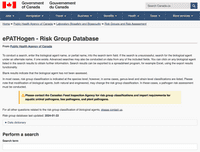
Languages: English, French
ePATHogen Risk Group Database
[ePATH]
The ePATHogen database contains a searchable list of nearly 8,000 pathogens with their associated human and animal risk group classifications, as well as toxins and their associated regulatory status. The database also includes the containment level required for each pathogen/toxin, Security Sensitive Biological Agent status, regulatory authority, and containment considerations.
SUMMARY
The ePATHogen Risk Group Database is published by the Public Health Agency of Canada’s (PHAC) and is freely available on the Government of Canada's website for all regulated parties and interested stakeholders to access. It was launched on July 31, 2018 and is updated daily. They continue to conduct risk assessments and additional biological agents are regularly added to the database. The ePATHogen database contains a searchable list of nearly 8,000 pathogens with their associated human and animal risk group classifications, as well as toxins and their associated regulatory status. The database also includes the containment level required for each pathogen/toxin, Security Sensitive Biological Agent status, regulatory authority, and containment considerations.
The launch of the ePATHogen database had a positive impact on regulated parties and interested stakeholders by allowing unrestricted access to the pathogen list and providing clarity regarding the regulatory authorities for animal pathogens. The ePATHogen database is available on the PHAC website in English and French and is part of a larger suite of biosafety and biosecurity resources maintained by the Canadian Centre for Biosecurity in collaboration with the Canadian Food Inspection Agency, Health Canada and PHAC. The Centre has 4 offices that focus on biosecurity: 1. Office of Biosafety Programs and Planning (OBPP), 2. Office of Biosafety and Biocontainment Operations (OBBO) , 3. Office of Pathogen Security (OPS), 4. Office of Stakeholder Engagement and Regulatory Affairs (OSERA).

..png)
